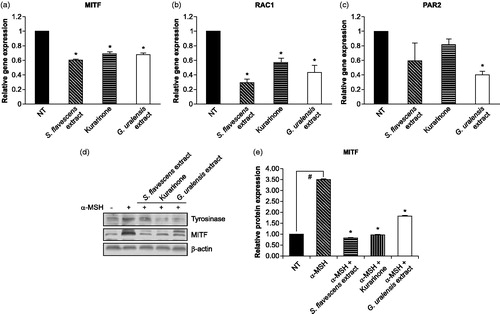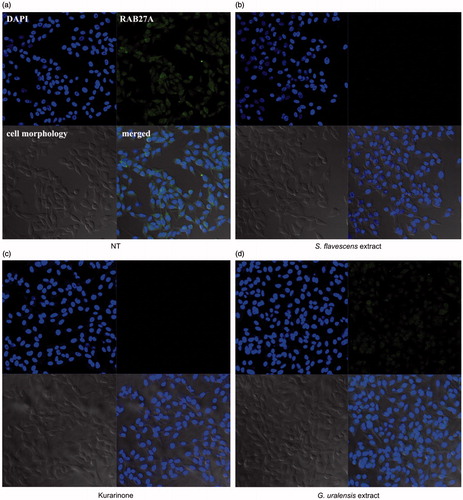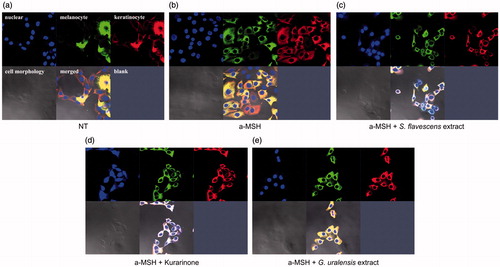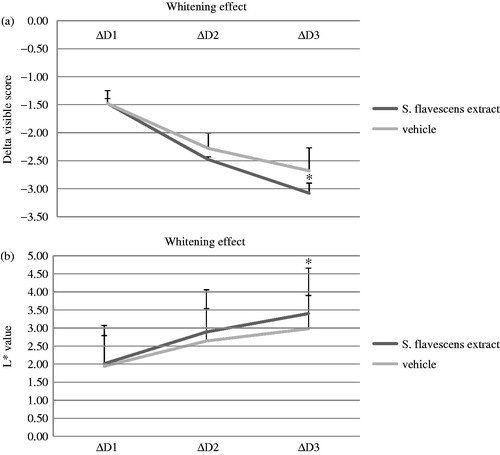Figures & data
Figure 1. Effects of S. flavescens extract on mRNA and protein expressions of melanosome formation and pigmentation-related genes in keratinocyte and melanoma cell lines. S. flavescens extract, G. uralensis extract and kurarinone regulate the expressions of MITF (a), RAC1 (b) and PAR2 (F2RL1) (c) genes, and MITF protein expression (d and e). (a–c) HaCaT keratinocyte cell lines were treated (GI50 concentration) with S. flavescens extract, G. uralensis extract and kurarinone for 6 h. The levels of related gene expression were determined by real-time PCR analysis. (d and e) SK-MEL-2 melanoma cell lines were treated with or without 160 ng/mL α-MSH for 6 h, and then cells were treated with S. flavescens extract, G. uralensis extract and kurarinone for 6 h. (d) The levels of tyrosinase and MITF expression were determined by western blot analysis. β-actin was used as an internal control for relative quantitation. (e) The S. flavescens extract decreased the level (approx. threefold) of α-MSH-induced MITF expression. Values are mean ± SD from three independent experiments. #p < 0.01 versus DMSO alone-treated group (NT). *p < 0.01 versus α-MSH alone-treated group.

Figure 2. Effects of S. flavescens extract on RAB27A expression in melanoma cell lines. S. flavescens extract and kurarinone regulate expression of RAB27A. SK-MEL-2 melanoma cell lines were transfected with pCNS-RAB27A for 24 h. After transfection, cells were treated with S. flavescens extract, G. uralensis extract and kurarinone for 6 h. (a) The 0.1% DMSO control shows normal distribution of RAB27A. However, levels of RAB27A were reduced by the S. flavescens extract and kurarinone (b, c), whereas higher levels of RAB27A were observed in the cells treated with G. uralensis extract (d).

Figure 3. Effects of S. flavescens extract on melanosome transfer in co-cultures of melanoma and keratinocyte cell lines. S. flavescens extract and kurarinone regulate melanosome transfer in co-cultures of SK-MEL-2 melanoma and HaCaT keratinocyte cell lines. Co-cultures were treated with or without α-MSH for 6 h, and then treated with S. flavescens extract, G. uralensis extract and kurarinone for 6 h. Double-immunofluorescence staining using anti-tyrosinase (green) to detect melanosomes and anti-cytokeratin (red) to detect keratinocytes was performed. The anti-tyrosinase image was merged with the red fluorescence signals emitted by keratinocytes, and shows the degree of melanosome transfer (yellow). (a, b) Degree of melanosome transfer in the absence or presence of α-MSH. (c, d) The degree of melanosome transfer is reduced in cells treated with S. flavescens extract and kurarinone, whereas those treated with G. uralensis extract had increased melanosome transfer (e).

Figure 4. The whitening effects of S. flavescens extract in human skin. Whitening effect of the formulation containing 0.05% S. flavescens extract on UVB-induced skin pigmentation. Three days after irradiation, subjects applied 0.05% S. flavescens lotion and vehicle (without 0.05% S. flavescens) on their respective sites twice a day (in the morning and evening) for 8 weeks. For a period of 8 weeks, the subjects were evaluated through visual assessment by experts and measured using a chromameter CR-400 for measuring the whitening effect at 0, 4, 6 and 8 weeks. The clinical efficacy evaluation after the use of the formulation containing 0.05% S. flavescens extract for 8 weeks showed that there was a significant effect on skin whitening compared with vehicle by visual assessment by a dermatologist (a) and chromameter measurement (b). The value of visual assessment indicates brightness ranging from white (visible score = 0) to black (visible score = 7). The L* value indicates brightness ranging from black (L* = 0) to white (L* = 100). X-axis index: ΔD1, 4-week (W) - 0W; ΔD2, 6W - 0W; and ΔD3, 8W - 0W.
